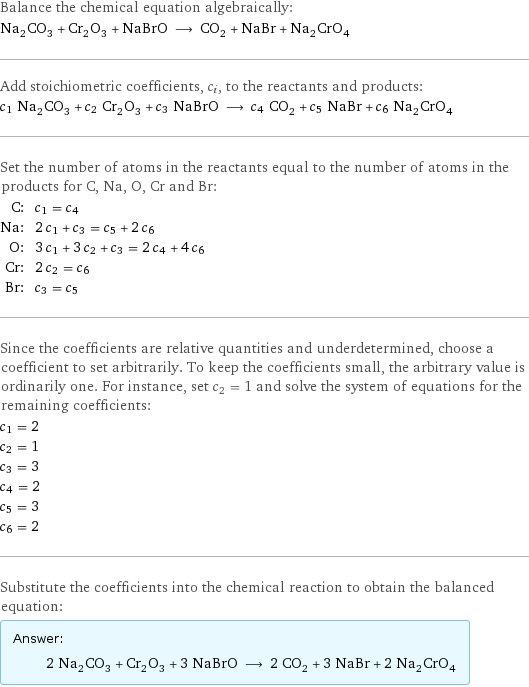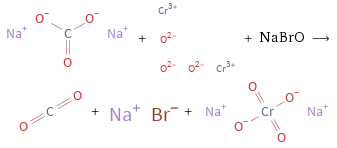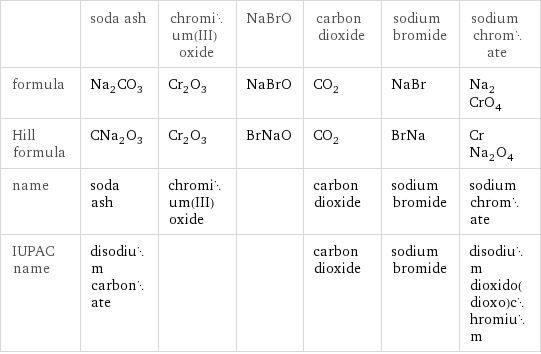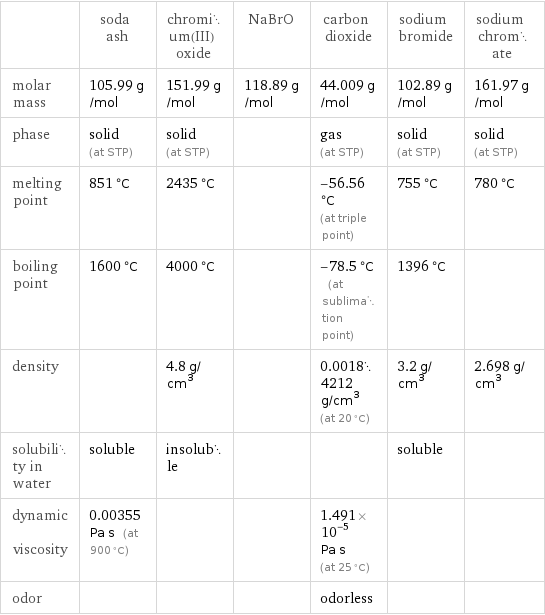Input interpretation

Na_2CO_3 soda ash + Cr_2O_3 chromium(III) oxide + NaBrO ⟶ CO_2 carbon dioxide + NaBr sodium bromide + Na_2CrO_4 sodium chromate
Balanced equation

Balance the chemical equation algebraically: Na_2CO_3 + Cr_2O_3 + NaBrO ⟶ CO_2 + NaBr + Na_2CrO_4 Add stoichiometric coefficients, c_i, to the reactants and products: c_1 Na_2CO_3 + c_2 Cr_2O_3 + c_3 NaBrO ⟶ c_4 CO_2 + c_5 NaBr + c_6 Na_2CrO_4 Set the number of atoms in the reactants equal to the number of atoms in the products for C, Na, O, Cr and Br: C: | c_1 = c_4 Na: | 2 c_1 + c_3 = c_5 + 2 c_6 O: | 3 c_1 + 3 c_2 + c_3 = 2 c_4 + 4 c_6 Cr: | 2 c_2 = c_6 Br: | c_3 = c_5 Since the coefficients are relative quantities and underdetermined, choose a coefficient to set arbitrarily. To keep the coefficients small, the arbitrary value is ordinarily one. For instance, set c_2 = 1 and solve the system of equations for the remaining coefficients: c_1 = 2 c_2 = 1 c_3 = 3 c_4 = 2 c_5 = 3 c_6 = 2 Substitute the coefficients into the chemical reaction to obtain the balanced equation: Answer: | | 2 Na_2CO_3 + Cr_2O_3 + 3 NaBrO ⟶ 2 CO_2 + 3 NaBr + 2 Na_2CrO_4
Structures

+ + NaBrO ⟶ + +
Names

soda ash + chromium(III) oxide + NaBrO ⟶ carbon dioxide + sodium bromide + sodium chromate
Equilibrium constant
![Construct the equilibrium constant, K, expression for: Na_2CO_3 + Cr_2O_3 + NaBrO ⟶ CO_2 + NaBr + Na_2CrO_4 Plan: • Balance the chemical equation. • Determine the stoichiometric numbers. • Assemble the activity expression for each chemical species. • Use the activity expressions to build the equilibrium constant expression. Write the balanced chemical equation: 2 Na_2CO_3 + Cr_2O_3 + 3 NaBrO ⟶ 2 CO_2 + 3 NaBr + 2 Na_2CrO_4 Assign stoichiometric numbers, ν_i, using the stoichiometric coefficients, c_i, from the balanced chemical equation in the following manner: ν_i = -c_i for reactants and ν_i = c_i for products: chemical species | c_i | ν_i Na_2CO_3 | 2 | -2 Cr_2O_3 | 1 | -1 NaBrO | 3 | -3 CO_2 | 2 | 2 NaBr | 3 | 3 Na_2CrO_4 | 2 | 2 Assemble the activity expressions accounting for the state of matter and ν_i: chemical species | c_i | ν_i | activity expression Na_2CO_3 | 2 | -2 | ([Na2CO3])^(-2) Cr_2O_3 | 1 | -1 | ([Cr2O3])^(-1) NaBrO | 3 | -3 | ([NaBrO])^(-3) CO_2 | 2 | 2 | ([CO2])^2 NaBr | 3 | 3 | ([NaBr])^3 Na_2CrO_4 | 2 | 2 | ([Na2CrO4])^2 The equilibrium constant symbol in the concentration basis is: K_c Mulitply the activity expressions to arrive at the K_c expression: Answer: | | K_c = ([Na2CO3])^(-2) ([Cr2O3])^(-1) ([NaBrO])^(-3) ([CO2])^2 ([NaBr])^3 ([Na2CrO4])^2 = (([CO2])^2 ([NaBr])^3 ([Na2CrO4])^2)/(([Na2CO3])^2 [Cr2O3] ([NaBrO])^3)](../image_source/b33adec6d8f0e719b64af29f13f9b72b.png)
Construct the equilibrium constant, K, expression for: Na_2CO_3 + Cr_2O_3 + NaBrO ⟶ CO_2 + NaBr + Na_2CrO_4 Plan: • Balance the chemical equation. • Determine the stoichiometric numbers. • Assemble the activity expression for each chemical species. • Use the activity expressions to build the equilibrium constant expression. Write the balanced chemical equation: 2 Na_2CO_3 + Cr_2O_3 + 3 NaBrO ⟶ 2 CO_2 + 3 NaBr + 2 Na_2CrO_4 Assign stoichiometric numbers, ν_i, using the stoichiometric coefficients, c_i, from the balanced chemical equation in the following manner: ν_i = -c_i for reactants and ν_i = c_i for products: chemical species | c_i | ν_i Na_2CO_3 | 2 | -2 Cr_2O_3 | 1 | -1 NaBrO | 3 | -3 CO_2 | 2 | 2 NaBr | 3 | 3 Na_2CrO_4 | 2 | 2 Assemble the activity expressions accounting for the state of matter and ν_i: chemical species | c_i | ν_i | activity expression Na_2CO_3 | 2 | -2 | ([Na2CO3])^(-2) Cr_2O_3 | 1 | -1 | ([Cr2O3])^(-1) NaBrO | 3 | -3 | ([NaBrO])^(-3) CO_2 | 2 | 2 | ([CO2])^2 NaBr | 3 | 3 | ([NaBr])^3 Na_2CrO_4 | 2 | 2 | ([Na2CrO4])^2 The equilibrium constant symbol in the concentration basis is: K_c Mulitply the activity expressions to arrive at the K_c expression: Answer: | | K_c = ([Na2CO3])^(-2) ([Cr2O3])^(-1) ([NaBrO])^(-3) ([CO2])^2 ([NaBr])^3 ([Na2CrO4])^2 = (([CO2])^2 ([NaBr])^3 ([Na2CrO4])^2)/(([Na2CO3])^2 [Cr2O3] ([NaBrO])^3)
Rate of reaction
![Construct the rate of reaction expression for: Na_2CO_3 + Cr_2O_3 + NaBrO ⟶ CO_2 + NaBr + Na_2CrO_4 Plan: • Balance the chemical equation. • Determine the stoichiometric numbers. • Assemble the rate term for each chemical species. • Write the rate of reaction expression. Write the balanced chemical equation: 2 Na_2CO_3 + Cr_2O_3 + 3 NaBrO ⟶ 2 CO_2 + 3 NaBr + 2 Na_2CrO_4 Assign stoichiometric numbers, ν_i, using the stoichiometric coefficients, c_i, from the balanced chemical equation in the following manner: ν_i = -c_i for reactants and ν_i = c_i for products: chemical species | c_i | ν_i Na_2CO_3 | 2 | -2 Cr_2O_3 | 1 | -1 NaBrO | 3 | -3 CO_2 | 2 | 2 NaBr | 3 | 3 Na_2CrO_4 | 2 | 2 The rate term for each chemical species, B_i, is 1/ν_i(Δ[B_i])/(Δt) where [B_i] is the amount concentration and t is time: chemical species | c_i | ν_i | rate term Na_2CO_3 | 2 | -2 | -1/2 (Δ[Na2CO3])/(Δt) Cr_2O_3 | 1 | -1 | -(Δ[Cr2O3])/(Δt) NaBrO | 3 | -3 | -1/3 (Δ[NaBrO])/(Δt) CO_2 | 2 | 2 | 1/2 (Δ[CO2])/(Δt) NaBr | 3 | 3 | 1/3 (Δ[NaBr])/(Δt) Na_2CrO_4 | 2 | 2 | 1/2 (Δ[Na2CrO4])/(Δt) (for infinitesimal rate of change, replace Δ with d) Set the rate terms equal to each other to arrive at the rate expression: Answer: | | rate = -1/2 (Δ[Na2CO3])/(Δt) = -(Δ[Cr2O3])/(Δt) = -1/3 (Δ[NaBrO])/(Δt) = 1/2 (Δ[CO2])/(Δt) = 1/3 (Δ[NaBr])/(Δt) = 1/2 (Δ[Na2CrO4])/(Δt) (assuming constant volume and no accumulation of intermediates or side products)](../image_source/8726a5c9eba2864a8fadb5984fdec139.png)
Construct the rate of reaction expression for: Na_2CO_3 + Cr_2O_3 + NaBrO ⟶ CO_2 + NaBr + Na_2CrO_4 Plan: • Balance the chemical equation. • Determine the stoichiometric numbers. • Assemble the rate term for each chemical species. • Write the rate of reaction expression. Write the balanced chemical equation: 2 Na_2CO_3 + Cr_2O_3 + 3 NaBrO ⟶ 2 CO_2 + 3 NaBr + 2 Na_2CrO_4 Assign stoichiometric numbers, ν_i, using the stoichiometric coefficients, c_i, from the balanced chemical equation in the following manner: ν_i = -c_i for reactants and ν_i = c_i for products: chemical species | c_i | ν_i Na_2CO_3 | 2 | -2 Cr_2O_3 | 1 | -1 NaBrO | 3 | -3 CO_2 | 2 | 2 NaBr | 3 | 3 Na_2CrO_4 | 2 | 2 The rate term for each chemical species, B_i, is 1/ν_i(Δ[B_i])/(Δt) where [B_i] is the amount concentration and t is time: chemical species | c_i | ν_i | rate term Na_2CO_3 | 2 | -2 | -1/2 (Δ[Na2CO3])/(Δt) Cr_2O_3 | 1 | -1 | -(Δ[Cr2O3])/(Δt) NaBrO | 3 | -3 | -1/3 (Δ[NaBrO])/(Δt) CO_2 | 2 | 2 | 1/2 (Δ[CO2])/(Δt) NaBr | 3 | 3 | 1/3 (Δ[NaBr])/(Δt) Na_2CrO_4 | 2 | 2 | 1/2 (Δ[Na2CrO4])/(Δt) (for infinitesimal rate of change, replace Δ with d) Set the rate terms equal to each other to arrive at the rate expression: Answer: | | rate = -1/2 (Δ[Na2CO3])/(Δt) = -(Δ[Cr2O3])/(Δt) = -1/3 (Δ[NaBrO])/(Δt) = 1/2 (Δ[CO2])/(Δt) = 1/3 (Δ[NaBr])/(Δt) = 1/2 (Δ[Na2CrO4])/(Δt) (assuming constant volume and no accumulation of intermediates or side products)
Chemical names and formulas

| soda ash | chromium(III) oxide | NaBrO | carbon dioxide | sodium bromide | sodium chromate formula | Na_2CO_3 | Cr_2O_3 | NaBrO | CO_2 | NaBr | Na_2CrO_4 Hill formula | CNa_2O_3 | Cr_2O_3 | BrNaO | CO_2 | BrNa | CrNa_2O_4 name | soda ash | chromium(III) oxide | | carbon dioxide | sodium bromide | sodium chromate IUPAC name | disodium carbonate | | | carbon dioxide | sodium bromide | disodium dioxido(dioxo)chromium
Substance properties

| soda ash | chromium(III) oxide | NaBrO | carbon dioxide | sodium bromide | sodium chromate molar mass | 105.99 g/mol | 151.99 g/mol | 118.89 g/mol | 44.009 g/mol | 102.89 g/mol | 161.97 g/mol phase | solid (at STP) | solid (at STP) | | gas (at STP) | solid (at STP) | solid (at STP) melting point | 851 °C | 2435 °C | | -56.56 °C (at triple point) | 755 °C | 780 °C boiling point | 1600 °C | 4000 °C | | -78.5 °C (at sublimation point) | 1396 °C | density | | 4.8 g/cm^3 | | 0.00184212 g/cm^3 (at 20 °C) | 3.2 g/cm^3 | 2.698 g/cm^3 solubility in water | soluble | insoluble | | | soluble | dynamic viscosity | 0.00355 Pa s (at 900 °C) | | | 1.491×10^-5 Pa s (at 25 °C) | | odor | | | | odorless | |
Units
